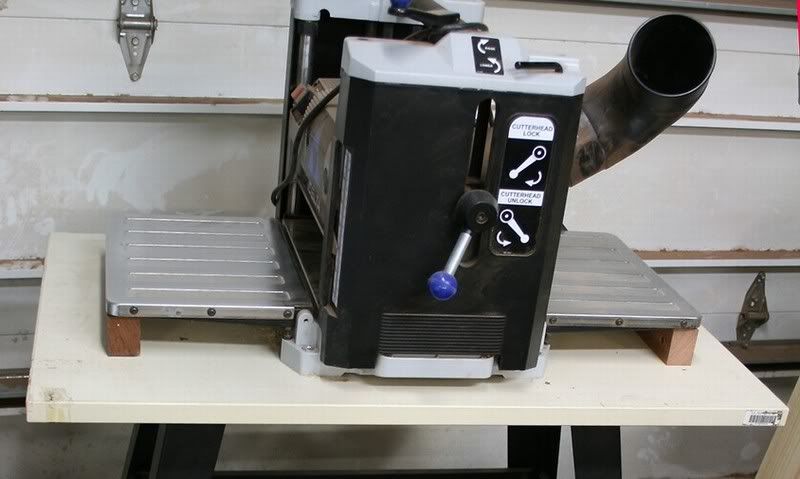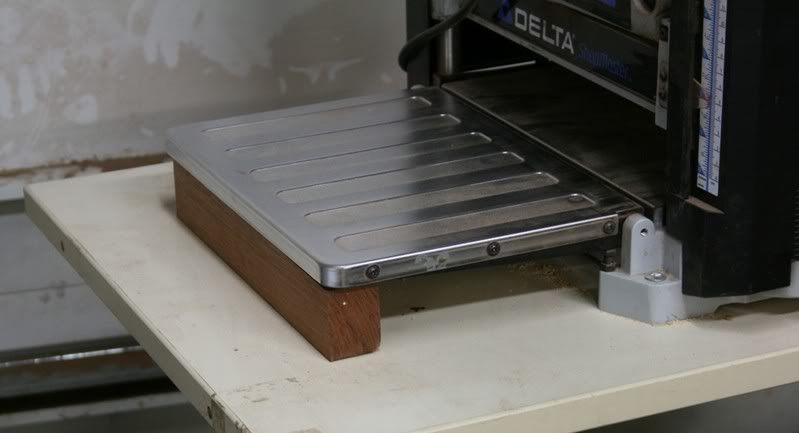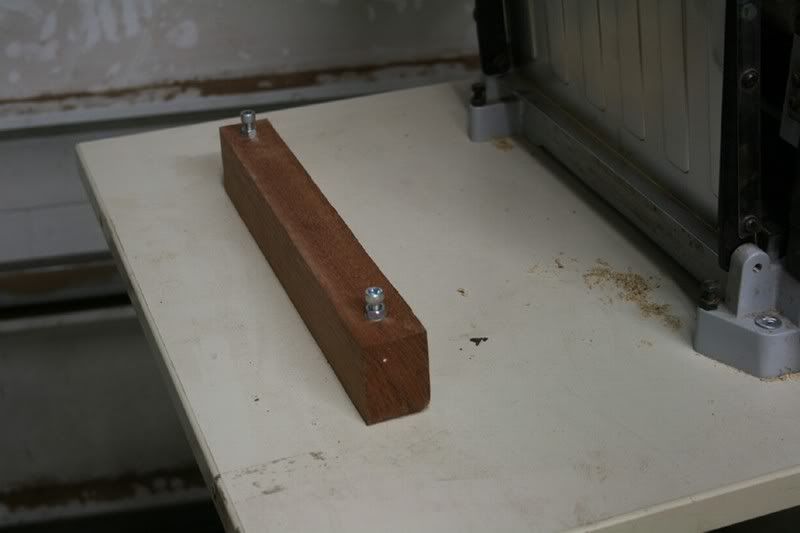 Thanks: 0
Thanks: 0
 Needs Pictures: 0
Needs Pictures: 0
 Picture(s) thanks: 0
Picture(s) thanks: 0
Results 1 to 10 of 10
Thread: Planer/Thicknesser Sniping issue
-
3rd June 2017, 04:21 PM #1
 New Member
New Member











- Join Date
- Jun 2017
- Location
- Wyalkatchem, WA
- Age
- 67
- Posts
- 1
 Planer/Thicknesser Sniping issue
Planer/Thicknesser Sniping issue
Greetings from the West,
I appologise in advance if this issue has been covered, but I recently purchased an AW106PT Planer thicknesser from CarbaTec and the manual is quite useless. I am trying to set up the machine so it doesn't snipe the end of the board and the manual does not cover this. Has anyone else had this issue and/or a successful outcome? I'm getting desperate and calling CarbaTec has not exactly been helpful.
Cheers,
Mark
-
3rd June 2017 04:21 PM # ADSGoogle Adsense Advertisement
- Join Date
- Always
- Location
- Advertising world
- Age
- 2010
- Posts
- Many
-
3rd June 2017, 04:52 PM #2

snipe is a given for a thicky
take it into account and allow extra for itregards
Nick
veni, vidi, tornavi
Without wood it's just ...
-
3rd June 2017, 05:19 PM #3

With some machines you can adjust the height of infeed/outfeed tables and/or use additional well adjusted outboard supports to give the greatest possible straight supported area for the boards. This reduces the tendency for boards to tip at the far end and raise the end nearest the cutters when it cannot be secured by both feed rollers. If you can get this properly tuned, it will minimise but rarely eliminate snipe all together.
The next solution is to thickness long length boards before you cut to length, that way you can trim out the 50-60mm at the end that has snipe. It is more economical to do the job this way than to break down into overlength boards where you may need 100-120mm extra overall for each component.
If the material you need to run through is relatively short, you can try making a false table from 40mm benchtop chipboard and high pressure laminate. The false table sits on the thicky bed and is also supported by the infeed/outfeed tables. It is longer than the overall length of the infeed table, thicky platten or base and outfeed table and has a securely mounted cleat running accross the underside to contact the indeed table end and prevent the false table feeding through the thicky. The concept is to provide a flat surface to feed the work across so that a single feed roller can secure the material and prevent it tilting at the opposite end.
If you need to thickness material that has been previously cut to final length, another trick is to hot glue a couple of sacrificial material to the edges of your component. These pieces need to be a little thicker than the component, and long enough to extend past the component each end to provide an adequate allowance for snipe. The first pass through the thicky will trim the sacrificial and work materials to a common thickness with any snipe occurring in the sacrificial material where it extends past the work material, leaving the work material snipe free once the sacrificial material is removed.I used to be an engineer, I'm not an engineer any more, but on the really good days I can remember when I was.
-
3rd June 2017, 05:44 PM #4
 SENIOR MEMBER
SENIOR MEMBER











- Join Date
- Apr 2007
- Location
- Sydney
- Posts
- 749

Wow MALB said!! You can get rid of it if you extend the tables. The concept in para 3 above will work to give you snipe free cuts if you extend the false table sufficiently and have it well supported at both ends, particularly the outfeed. This video has a good explanation - although it's for a lunch box thicky, you could apply the same design to your machine
-
3rd June 2017, 05:45 PM #5

Check the flex in the in/outfeed tables. If they move, the board will pivot into the blades. That is what causes snipe. Long boards are more at risk here.
The solution is to level the tables, ensuring that they are coplanar, and then fix them in place. You can either fix the tables ...



... or you can add a dedicated sub-table made from a few lengths of MDF or plywood, which lie through the machine and on top of the beds.
Regards fromm Perth
DerekVisit www.inthewoodshop.com for tutorials on constructing handtools, handtool reviews, and my trials and tribulations with furniture builds.
-
3rd June 2017, 07:13 PM #6

Ooops......Carbatec planer/thicknesser isn't one of the benchtop models, its a combo machine
-
3rd June 2017, 07:30 PM #7
 GOLD MEMBER
GOLD MEMBER

- Join Date
- May 2015
- Location
- Brisbane
- Posts
- 1,147

I made an extended indfeed outfield bed for mine from 16mm melamine board with a cleat at each end to keep it in place and while this helped a little it did not eliminate the problem when feeding the timber in straight.
The most effective way i found to reduce snipe to near nothing is to feed the timber in on an angle so the cut starts on the left and finishes on the right, or vice versa.
-
3rd June 2017, 09:48 PM #8

I've seen a couple of youtubes on snipe that suggest it's something that happens to all machines.
One of the youtubes made a good suggestion and I used the method myself; it's a sacrifice lead in board and then follow board, so that the snipe is on these pieces and not the good timber I'm trying to size...
It worked for me, Cheers, crowie
-
3rd June 2017, 10:36 PM #9
 GOLD MEMBER
GOLD MEMBER











- Join Date
- Oct 2014
- Location
- Caroline Springs, VIC
- Posts
- 1,645

thicknesser snipe happens for a range of reasons. poor machine setup is a good cause. poor machine build quality is a great one (benchtop thicknessers!). But a common one which has happened on every single thicknesser I have ever used is simply the variance in pressure applied to the timber as it enters and exits the machine. When you shove the timber into the machine and the rollers grab the board, the inexperienced or lazy have the tendency to let go and let the machine do everything. What happens is the trailing end sags under the weight of the board, thanks to gravity which in turn raises the leading end. The front serrated roller needs to not only feed the board through, but also compensate for the trailing sag by applying downward pressure, often spring loaded. So the answer would seem simple, just increase the downward pressure to 10 million tonnes and call it a day. But now you need a massive motor to push the timber along the thicknesser bed because of the 10million tonnes of friction. so there is a bit of give n take with downward pressure and feed motor power, and often it ends up being not enough pressure which can allow the snipe to happen. the way to combat this is to help the machine.
using a 1000x150x25 board as the example. Shove the board into the machine. Left hand on top of the board somewhere in the center, 500mm from the leading end, pushing downwards but not so hard as to lift the leading end. Right hand on the trailing end, slightly lifting the board to compensate for what the left hand is doing. Try to get a slight belly in the board while maintaining the trailing end being higher than the thicknesser bed. doing this puts alot of downward force onto the thicknesser bed at the leading end just as the thicknesser begins to cut the board while only one feed roller is in contact with the board. wham bam, problem solved or your machine is setup wrong with feed rollers set too high/low or too much/little pressure. reverse the operation for tailing out of the machine by lifting the leading end etc etc.
if I am ever thicknessing ~5mm thick stock, you will see me lift the trailing end of the pieces to about shoulder height. because when timber is that thin, it can bend easily and the distance between the feed roller and cutter is enough that the timber can bend between these two points. the idea is to get as much pressure on the leading end as possible so it won't bend.
butt feeding timbers all but eliminates the majority of snipe, except on the first and last piece. it is only on the first and last piece that I bother to bend the boards.
-
4th June 2017, 01:43 AM #10
 SENIOR MEMBER
SENIOR MEMBER











- Join Date
- Aug 2013
- Location
- Montmorency Victoria
- Posts
- 554

Hi Mark,
I have the same machine .. with the helix head and I think it is a great machine ( there are better out there for much more money) ... but this one does all I ask.
Are you having issues with the jointer sniping or the thicknesser ... or both?
Sniping .. as said above has a number of causes ... including technique. Remember when jointing that after the front has passed over the head to push down on the outfeed table end of the wood only .. about 100mm past the blade opening, while pushing forward with the other hand, in a hand over hand approach.
When feeding into the thicknesser the board has to be flat on the table ... and the leading end should not be allowed to drop down as it passes off the outfeed table (raises the end piece if it does).
To adjust the jointer to get it co-planar you must have a dial indicator and a strait edge, some open ended spanners ... and patience. ... to get the best result.
It should be setup from the factory ... but as it says in the manual (you are right it is pretty bad) do not lift the machine by the table ..
The jointer table is adjustable in all directions ... NSE and W. First job is to see if the top of the blade at its Top Dead Centre is level with the outfeed table. Lots of folk do this with 200mm scrap of wood resting over the blades between the infeed and outfeed table when the table is set to zero (all the way up) .. turn the blades and the scrap should be lifted by the blade and moved forward between 2 and 3 mm .. on the front and back of the blade. I use a dial indicator to set the blade at TDC to 0.03mm above the outfeed table .. this gives me best outcomes. This is the measurement near the head ...The strait edge is to ensure that the table is flat its entire length from one end of the infeed to the end of the outfeed table... no dips or crests in the middle.
You should never need to touch the height adjusting handle on the outfeed table ... it should be factory set. Be warned ... if you plan on fiddling with the height adjustment bolts (2 each near the table release cams) you will need to be patient and every so mindful that even a 1/4 turn makes a big difference not only on the table height along the table but also across the table. An across the table variance will mean that the fence can be 90 degrees on the outfeed table and something else of the infeed table .. or vv.
My advice would be to do the scrap wood approach first .. in if it is OK then develop your technique. A poor technique can result in snipe .. and, for the jointer, bowing the edge.
Dont forget to oil the bearings every month .. need to take the back off ... its in the manual.
Oh and BTW these dials are fantastic ... it measures the thickness of the planer head above the table ... you will appreciate it and use it all the time to get cuts 0.05mm perfect Axminster Digital Thickness Display - Planer Accessories - Planing - Machinery Accessories - Accessories | Axminster Tools & Machinery
Similar Threads
-
Makita N2012NB thicknesser issue
By Sam in forum GENERAL & SMALL MACHINERYReplies: 2Last Post: 1st June 2017, 11:24 PM -
Jet JWP13dx Thicknesser Issue
By Reyon in forum GENERAL & SMALL MACHINERYReplies: 2Last Post: 31st August 2016, 10:52 AM -
Delta thicknesser issue
By Chrism3 in forum WOODWORK - GENERALReplies: 0Last Post: 24th August 2015, 11:31 AM -
15" Thicknesser Starter Contactor Issue
By dwp in forum JOINTERS, MOULDERS, THICKNESSERS, ETCReplies: 0Last Post: 14th July 2012, 12:13 PM -
On-line auctions and sniping.
By Driver in forum NOTHING AT ALL TO DO WITH WOODWORKReplies: 30Last Post: 10th December 2005, 07:25 PM



 Likes:
Likes: 
 Reply With Quote
Reply With Quote
